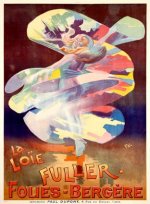|
 Best known as a pioneer in the fields of modern dance and theatrical lighting, Loie Fuller was one of very few dancers who not only permitted the filming of her performances, but also encouraged it. It is largely thanks to Fuller that early modern dance was filmed at all. Born outside of Chicago to a struggling family who later moved west and found success in business, Fuller was a child actress. By her teens she was choreographing and performing in burlesque, vaudeville, and circus shows. Like Isadora Duncan, Fuller embraced the ideas of free dance and improvisation. Her technique of combining choreography with flowing silk costumes illuminated by colorful lighting sets Fuller apart from other modern dance pioneers. She transferred her lighting techniques to film, and hand colored each frame in multi-color. Her most famous work, the “Serpentine Dance” (1891) brought her acclaim, and she was enthusiastically received in Europe, particularly Paris. She was in fact the first American modern dancer to perform in Europe, and paved the way for Isadora Duncan. Her efforts in Europe are significant to dance history, as at the time Ballet reigned supreme and modern dance was considered a fad at best and barbaric at worst. Fuller is largely responsible for influencing Europeans to accept modern dance as a serious art form. She became a regular performer with the Folies Bergere. Prominent European artists and scientists were impressed with Fuller’s lighting techniques and that she had patented her designs and compounds used to create the colors. Poets, too, were impressed with Fuller. William Butler Yeats featured Fuller’s "Chinese dancers" in his poem "Nineteen Hundred and Nineteen." She was an influence to artist Toulouse-Lautrec, who sketched her during a performance in Paris. She authored a memoir entitled, Fifteen Years of a Dancer’s Life (1913). Best known as a pioneer in the fields of modern dance and theatrical lighting, Loie Fuller was one of very few dancers who not only permitted the filming of her performances, but also encouraged it. It is largely thanks to Fuller that early modern dance was filmed at all. Born outside of Chicago to a struggling family who later moved west and found success in business, Fuller was a child actress. By her teens she was choreographing and performing in burlesque, vaudeville, and circus shows. Like Isadora Duncan, Fuller embraced the ideas of free dance and improvisation. Her technique of combining choreography with flowing silk costumes illuminated by colorful lighting sets Fuller apart from other modern dance pioneers. She transferred her lighting techniques to film, and hand colored each frame in multi-color. Her most famous work, the “Serpentine Dance” (1891) brought her acclaim, and she was enthusiastically received in Europe, particularly Paris. She was in fact the first American modern dancer to perform in Europe, and paved the way for Isadora Duncan. Her efforts in Europe are significant to dance history, as at the time Ballet reigned supreme and modern dance was considered a fad at best and barbaric at worst. Fuller is largely responsible for influencing Europeans to accept modern dance as a serious art form. She became a regular performer with the Folies Bergere. Prominent European artists and scientists were impressed with Fuller’s lighting techniques and that she had patented her designs and compounds used to create the colors. Poets, too, were impressed with Fuller. William Butler Yeats featured Fuller’s "Chinese dancers" in his poem "Nineteen Hundred and Nineteen." She was an influence to artist Toulouse-Lautrec, who sketched her during a performance in Paris. She authored a memoir entitled, Fifteen Years of a Dancer’s Life (1913).
Fuller’s travel and acclaim permitted her to move in certain exalted circles. She befriended Queen Marie of Romania and the Crown Prince Carol. Fuller remained in Paris for most of the remainder of her life, though she occasionally returned to the United States. She died of breast cancer, in Paris, in 1928 and is buried there.
Fuller continues to prove an inspiration to dancers and choreographers. Interest in her work has revived in recent years, including reconstructions of her most famous dances.
Image: Poster for Loïe Fuller at the Folies Bergère, late nineteenth century.
|